Integrated Infrastructure Project: Hyderabad Metro Rail PPP Case Study
VerifiedAdded on 2023/01/19
|13
|2837
|99
Report
AI Summary
This report presents a comprehensive case study of the Hyderabad Metro Rail project, focusing on its execution as a Public-Private Partnership (PPP). It begins with an identification and assessment of key challenges, including land acquisition, corridor extensions, traffic congestion, and environmental concerns. The report then examines how project leadership managed and overcame these challenges, highlighting the strategies employed to mitigate issues. A detailed stakeholder analysis follows, identifying key stakeholders such as project directors, investors, and the public, and analyzing their levels of involvement, interests, and potential tensions. The report also explores the project's funding model, financial arrangements, and the trade-offs between infrastructure development and service provision. Finally, it identifies opportunities for improvement in stakeholder management and financial planning, offering insights into best practices for future infrastructure projects. The analysis provides valuable insights into the complexities of large-scale infrastructure projects and the importance of effective project management in overcoming challenges and achieving project goals.
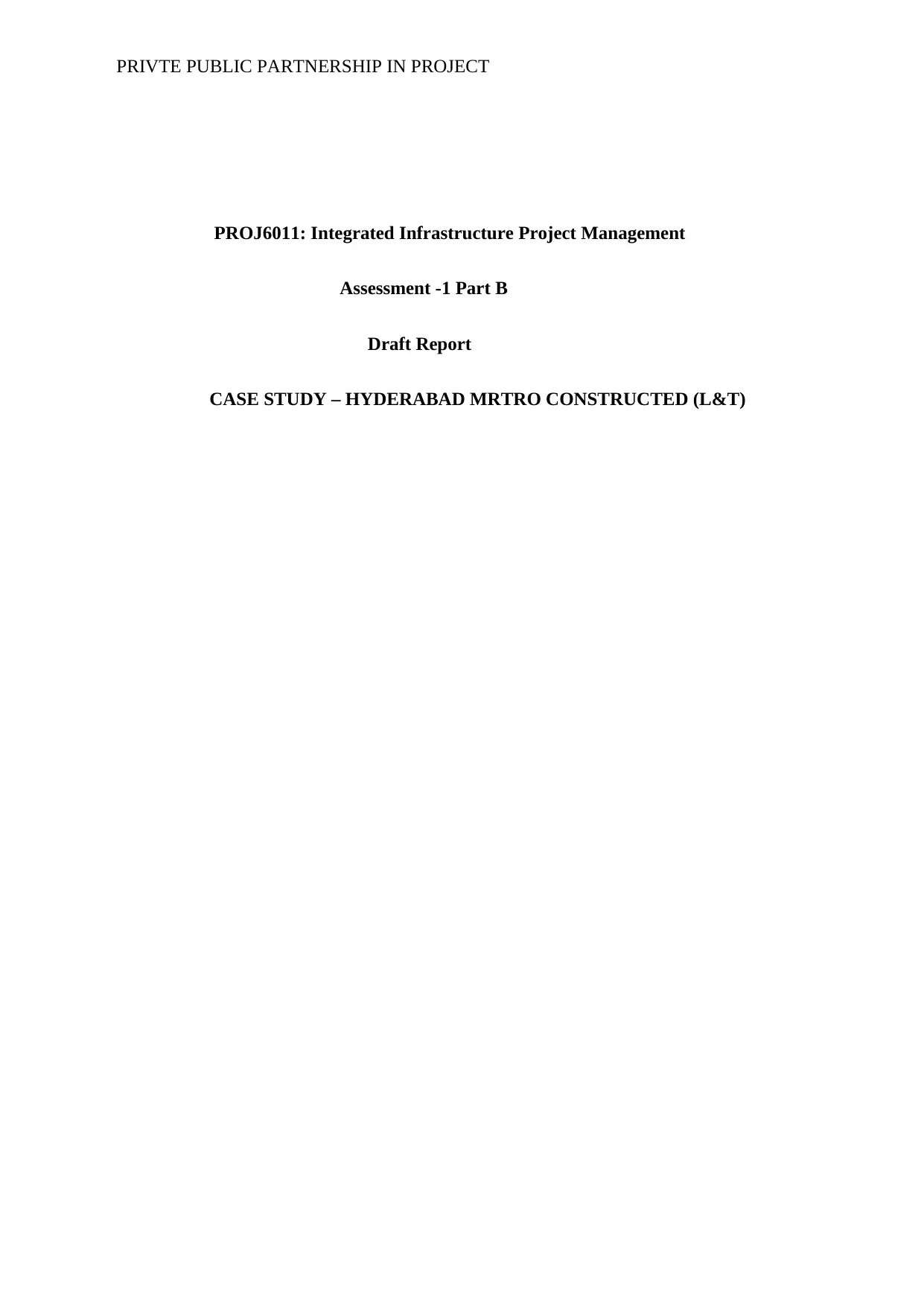
PRIVTE PUBLIC PARTNERSHIP IN PROJECT
PROJ6011: Integrated Infrastructure Project Management
Assessment -1 Part B
Draft Report
CASE STUDY – HYDERABAD MRTRO CONSTRUCTED (L&T)
PROJ6011: Integrated Infrastructure Project Management
Assessment -1 Part B
Draft Report
CASE STUDY – HYDERABAD MRTRO CONSTRUCTED (L&T)
Paraphrase This Document
Need a fresh take? Get an instant paraphrase of this document with our AI Paraphraser
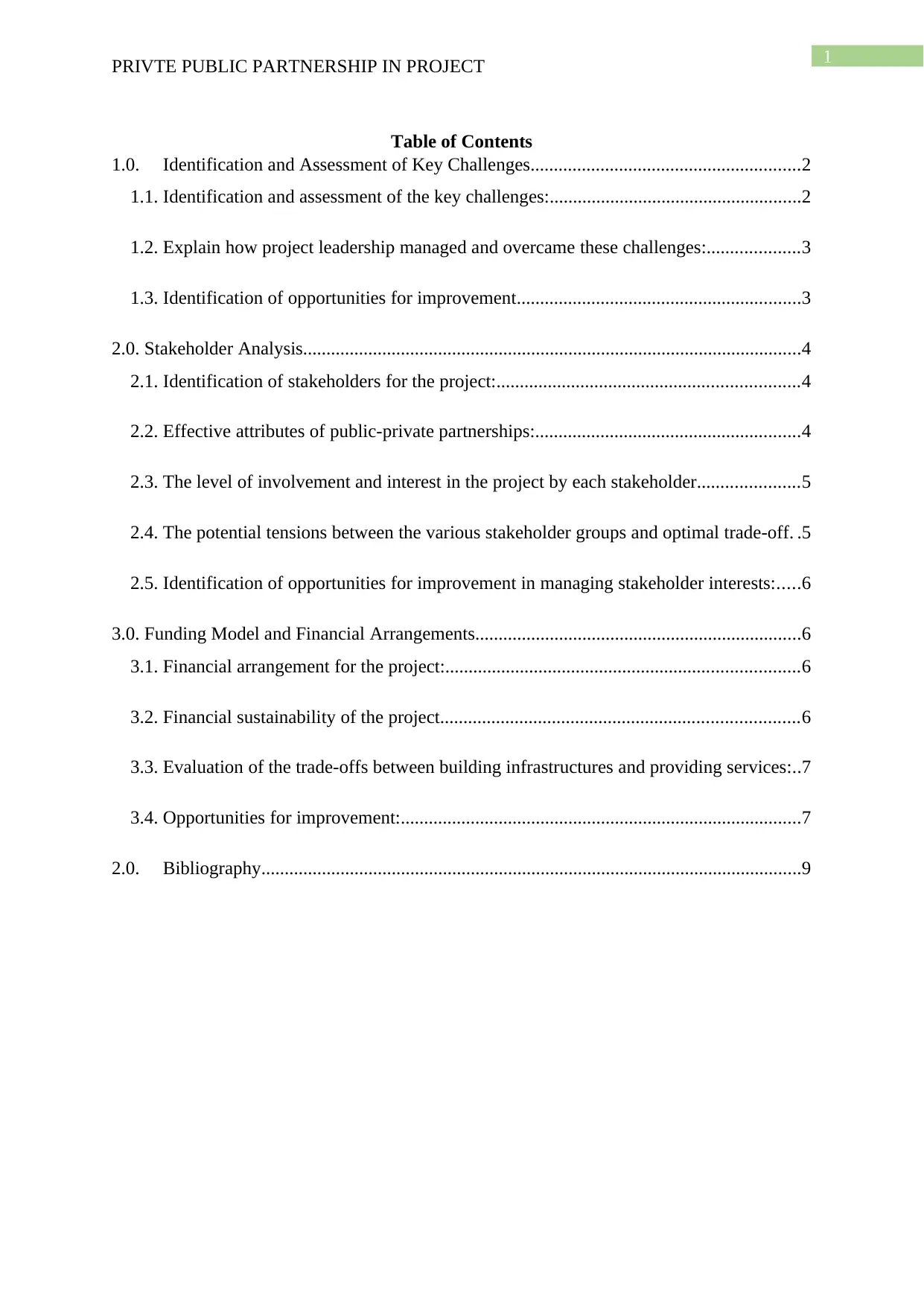
1
PRIVTE PUBLIC PARTNERSHIP IN PROJECT
Table of Contents
1.0. Identification and Assessment of Key Challenges..........................................................2
1.1. Identification and assessment of the key challenges:......................................................2
1.2. Explain how project leadership managed and overcame these challenges:....................3
1.3. Identification of opportunities for improvement.............................................................3
2.0. Stakeholder Analysis...........................................................................................................4
2.1. Identification of stakeholders for the project:.................................................................4
2.2. Effective attributes of public-private partnerships:.........................................................4
2.3. The level of involvement and interest in the project by each stakeholder......................5
2.4. The potential tensions between the various stakeholder groups and optimal trade-off. .5
2.5. Identification of opportunities for improvement in managing stakeholder interests:.....6
3.0. Funding Model and Financial Arrangements......................................................................6
3.1. Financial arrangement for the project:............................................................................6
3.2. Financial sustainability of the project.............................................................................6
3.3. Evaluation of the trade-offs between building infrastructures and providing services:..7
3.4. Opportunities for improvement:......................................................................................7
2.0. Bibliography....................................................................................................................9
PRIVTE PUBLIC PARTNERSHIP IN PROJECT
Table of Contents
1.0. Identification and Assessment of Key Challenges..........................................................2
1.1. Identification and assessment of the key challenges:......................................................2
1.2. Explain how project leadership managed and overcame these challenges:....................3
1.3. Identification of opportunities for improvement.............................................................3
2.0. Stakeholder Analysis...........................................................................................................4
2.1. Identification of stakeholders for the project:.................................................................4
2.2. Effective attributes of public-private partnerships:.........................................................4
2.3. The level of involvement and interest in the project by each stakeholder......................5
2.4. The potential tensions between the various stakeholder groups and optimal trade-off. .5
2.5. Identification of opportunities for improvement in managing stakeholder interests:.....6
3.0. Funding Model and Financial Arrangements......................................................................6
3.1. Financial arrangement for the project:............................................................................6
3.2. Financial sustainability of the project.............................................................................6
3.3. Evaluation of the trade-offs between building infrastructures and providing services:..7
3.4. Opportunities for improvement:......................................................................................7
2.0. Bibliography....................................................................................................................9
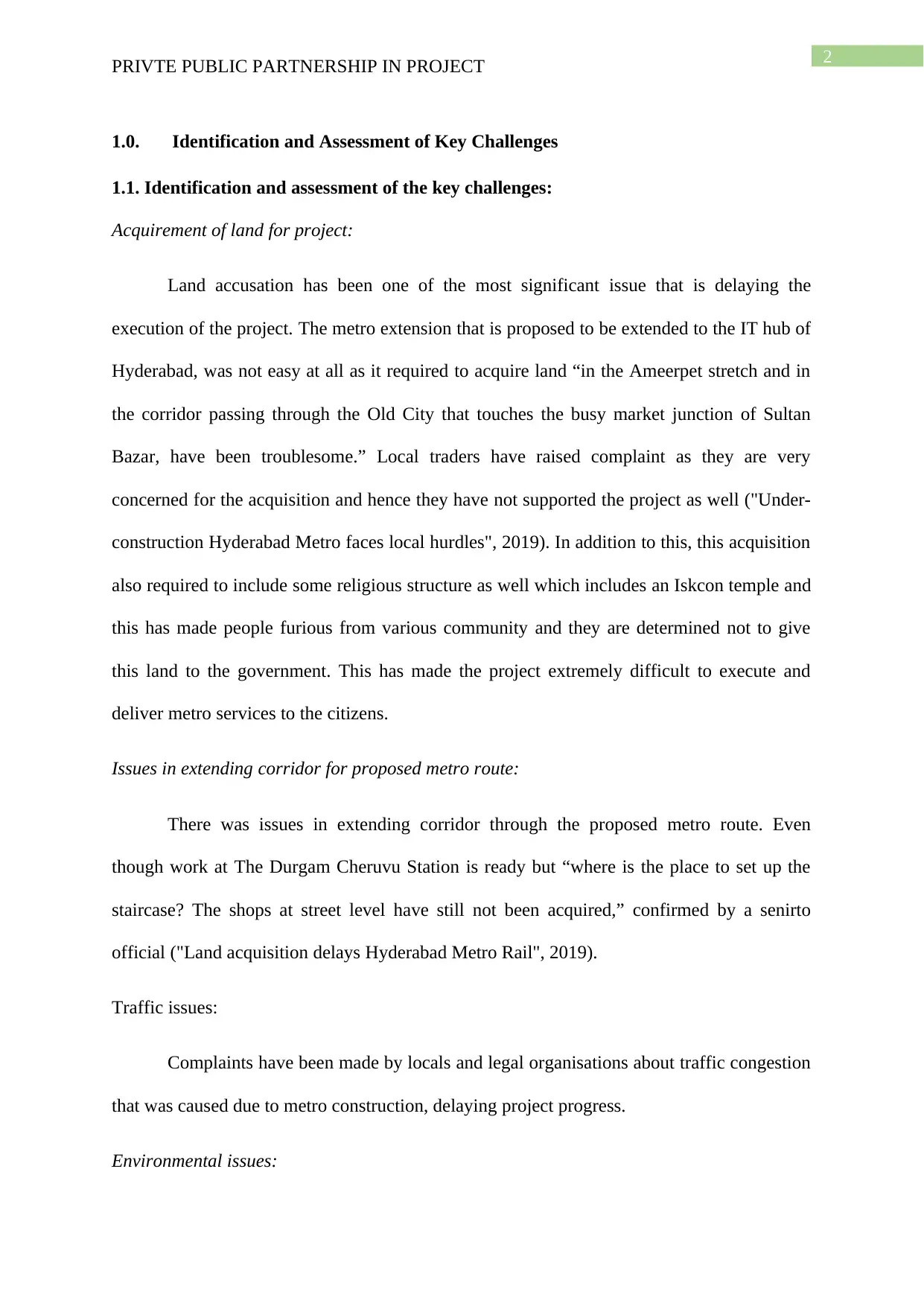
2
PRIVTE PUBLIC PARTNERSHIP IN PROJECT
1.0. Identification and Assessment of Key Challenges
1.1. Identification and assessment of the key challenges:
Acquirement of land for project:
Land accusation has been one of the most significant issue that is delaying the
execution of the project. The metro extension that is proposed to be extended to the IT hub of
Hyderabad, was not easy at all as it required to acquire land “in the Ameerpet stretch and in
the corridor passing through the Old City that touches the busy market junction of Sultan
Bazar, have been troublesome.” Local traders have raised complaint as they are very
concerned for the acquisition and hence they have not supported the project as well ("Under-
construction Hyderabad Metro faces local hurdles", 2019). In addition to this, this acquisition
also required to include some religious structure as well which includes an Iskcon temple and
this has made people furious from various community and they are determined not to give
this land to the government. This has made the project extremely difficult to execute and
deliver metro services to the citizens.
Issues in extending corridor for proposed metro route:
There was issues in extending corridor through the proposed metro route. Even
though work at The Durgam Cheruvu Station is ready but “where is the place to set up the
staircase? The shops at street level have still not been acquired,” confirmed by a senirto
official ("Land acquisition delays Hyderabad Metro Rail", 2019).
Traffic issues:
Complaints have been made by locals and legal organisations about traffic congestion
that was caused due to metro construction, delaying project progress.
Environmental issues:
PRIVTE PUBLIC PARTNERSHIP IN PROJECT
1.0. Identification and Assessment of Key Challenges
1.1. Identification and assessment of the key challenges:
Acquirement of land for project:
Land accusation has been one of the most significant issue that is delaying the
execution of the project. The metro extension that is proposed to be extended to the IT hub of
Hyderabad, was not easy at all as it required to acquire land “in the Ameerpet stretch and in
the corridor passing through the Old City that touches the busy market junction of Sultan
Bazar, have been troublesome.” Local traders have raised complaint as they are very
concerned for the acquisition and hence they have not supported the project as well ("Under-
construction Hyderabad Metro faces local hurdles", 2019). In addition to this, this acquisition
also required to include some religious structure as well which includes an Iskcon temple and
this has made people furious from various community and they are determined not to give
this land to the government. This has made the project extremely difficult to execute and
deliver metro services to the citizens.
Issues in extending corridor for proposed metro route:
There was issues in extending corridor through the proposed metro route. Even
though work at The Durgam Cheruvu Station is ready but “where is the place to set up the
staircase? The shops at street level have still not been acquired,” confirmed by a senirto
official ("Land acquisition delays Hyderabad Metro Rail", 2019).
Traffic issues:
Complaints have been made by locals and legal organisations about traffic congestion
that was caused due to metro construction, delaying project progress.
Environmental issues:
⊘ This is a preview!⊘
Do you want full access?
Subscribe today to unlock all pages.

Trusted by 1+ million students worldwide
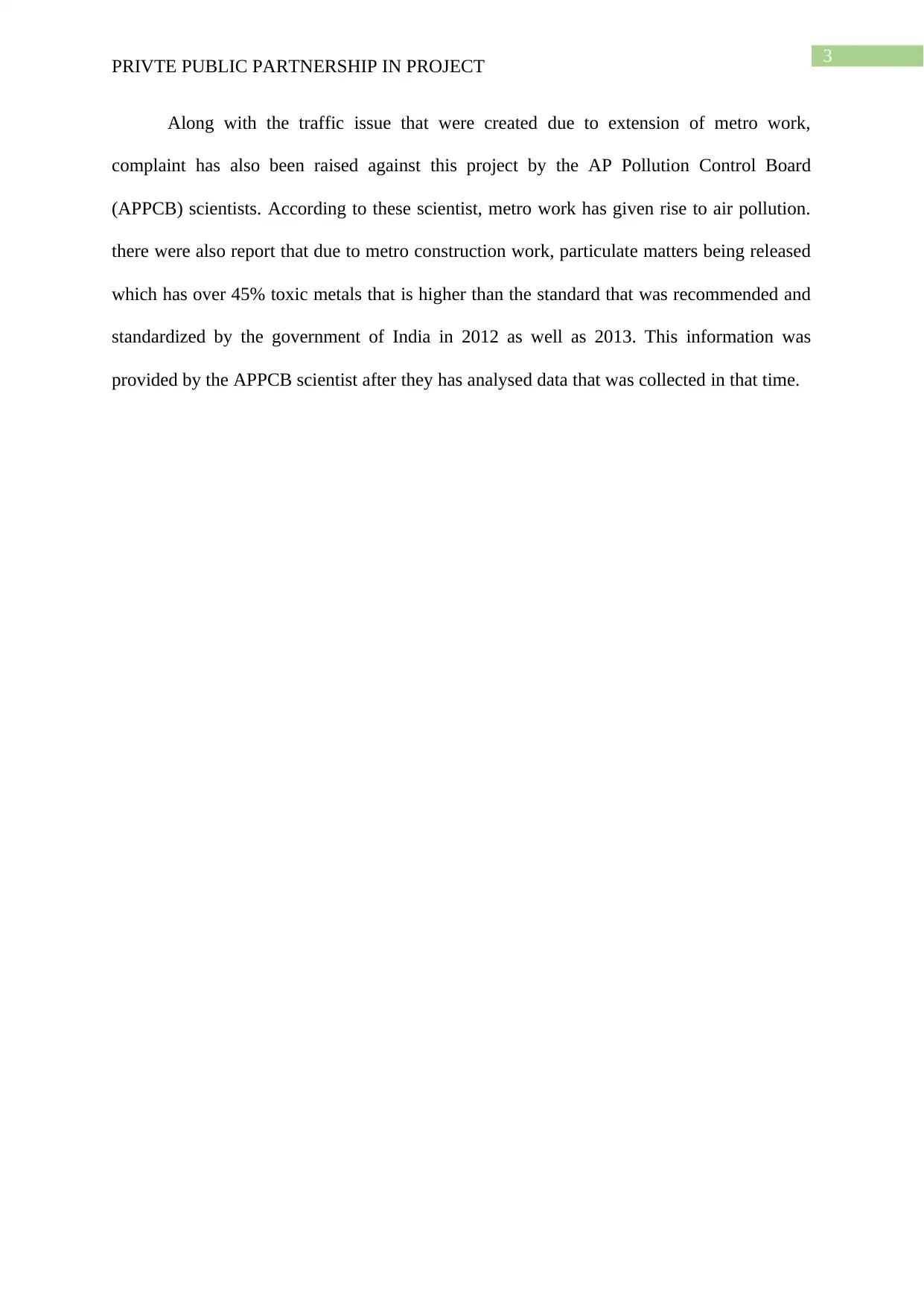
3
PRIVTE PUBLIC PARTNERSHIP IN PROJECT
Along with the traffic issue that were created due to extension of metro work,
complaint has also been raised against this project by the AP Pollution Control Board
(APPCB) scientists. According to these scientist, metro work has given rise to air pollution.
there were also report that due to metro construction work, particulate matters being released
which has over 45% toxic metals that is higher than the standard that was recommended and
standardized by the government of India in 2012 as well as 2013. This information was
provided by the APPCB scientist after they has analysed data that was collected in that time.
PRIVTE PUBLIC PARTNERSHIP IN PROJECT
Along with the traffic issue that were created due to extension of metro work,
complaint has also been raised against this project by the AP Pollution Control Board
(APPCB) scientists. According to these scientist, metro work has given rise to air pollution.
there were also report that due to metro construction work, particulate matters being released
which has over 45% toxic metals that is higher than the standard that was recommended and
standardized by the government of India in 2012 as well as 2013. This information was
provided by the APPCB scientist after they has analysed data that was collected in that time.
Paraphrase This Document
Need a fresh take? Get an instant paraphrase of this document with our AI Paraphraser
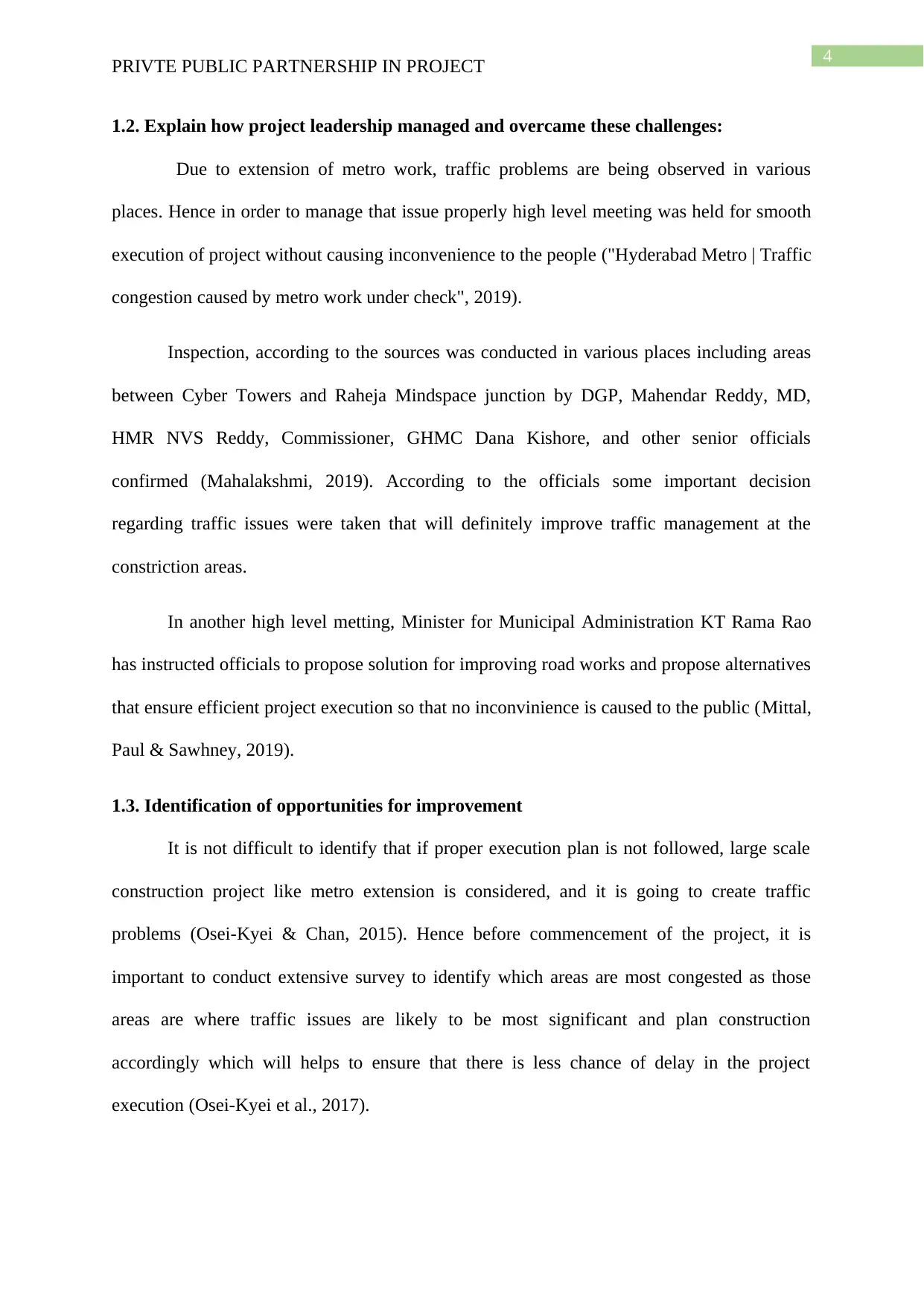
4
PRIVTE PUBLIC PARTNERSHIP IN PROJECT
1.2. Explain how project leadership managed and overcame these challenges:
Due to extension of metro work, traffic problems are being observed in various
places. Hence in order to manage that issue properly high level meeting was held for smooth
execution of project without causing inconvenience to the people ("Hyderabad Metro | Traffic
congestion caused by metro work under check", 2019).
Inspection, according to the sources was conducted in various places including areas
between Cyber Towers and Raheja Mindspace junction by DGP, Mahendar Reddy, MD,
HMR NVS Reddy, Commissioner, GHMC Dana Kishore, and other senior officials
confirmed (Mahalakshmi, 2019). According to the officials some important decision
regarding traffic issues were taken that will definitely improve traffic management at the
constriction areas.
In another high level metting, Minister for Municipal Administration KT Rama Rao
has instructed officials to propose solution for improving road works and propose alternatives
that ensure efficient project execution so that no inconvinience is caused to the public (Mittal,
Paul & Sawhney, 2019).
1.3. Identification of opportunities for improvement
It is not difficult to identify that if proper execution plan is not followed, large scale
construction project like metro extension is considered, and it is going to create traffic
problems (Osei-Kyei & Chan, 2015). Hence before commencement of the project, it is
important to conduct extensive survey to identify which areas are most congested as those
areas are where traffic issues are likely to be most significant and plan construction
accordingly which will helps to ensure that there is less chance of delay in the project
execution (Osei-Kyei et al., 2017).
PRIVTE PUBLIC PARTNERSHIP IN PROJECT
1.2. Explain how project leadership managed and overcame these challenges:
Due to extension of metro work, traffic problems are being observed in various
places. Hence in order to manage that issue properly high level meeting was held for smooth
execution of project without causing inconvenience to the people ("Hyderabad Metro | Traffic
congestion caused by metro work under check", 2019).
Inspection, according to the sources was conducted in various places including areas
between Cyber Towers and Raheja Mindspace junction by DGP, Mahendar Reddy, MD,
HMR NVS Reddy, Commissioner, GHMC Dana Kishore, and other senior officials
confirmed (Mahalakshmi, 2019). According to the officials some important decision
regarding traffic issues were taken that will definitely improve traffic management at the
constriction areas.
In another high level metting, Minister for Municipal Administration KT Rama Rao
has instructed officials to propose solution for improving road works and propose alternatives
that ensure efficient project execution so that no inconvinience is caused to the public (Mittal,
Paul & Sawhney, 2019).
1.3. Identification of opportunities for improvement
It is not difficult to identify that if proper execution plan is not followed, large scale
construction project like metro extension is considered, and it is going to create traffic
problems (Osei-Kyei & Chan, 2015). Hence before commencement of the project, it is
important to conduct extensive survey to identify which areas are most congested as those
areas are where traffic issues are likely to be most significant and plan construction
accordingly which will helps to ensure that there is less chance of delay in the project
execution (Osei-Kyei et al., 2017).
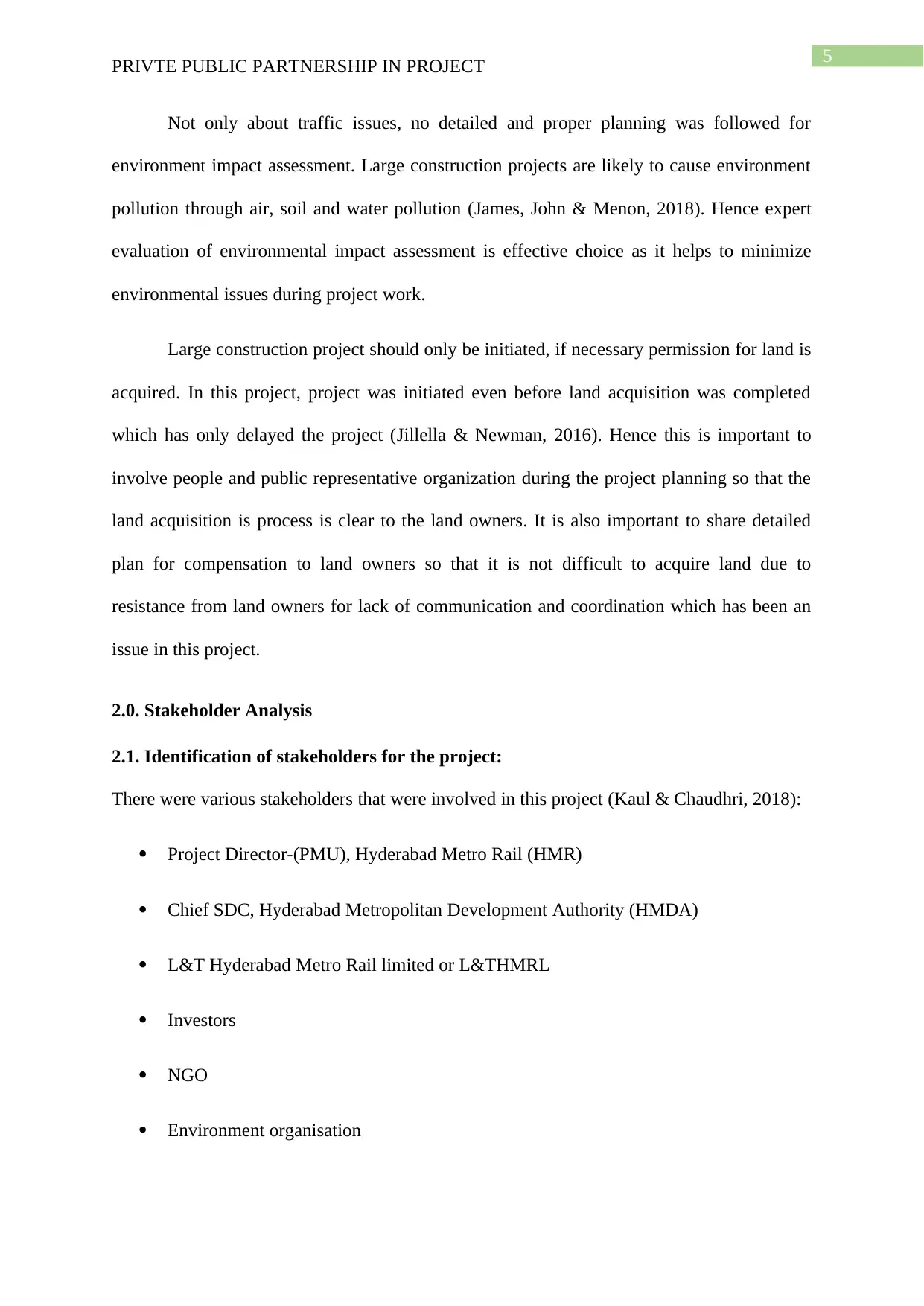
5
PRIVTE PUBLIC PARTNERSHIP IN PROJECT
Not only about traffic issues, no detailed and proper planning was followed for
environment impact assessment. Large construction projects are likely to cause environment
pollution through air, soil and water pollution (James, John & Menon, 2018). Hence expert
evaluation of environmental impact assessment is effective choice as it helps to minimize
environmental issues during project work.
Large construction project should only be initiated, if necessary permission for land is
acquired. In this project, project was initiated even before land acquisition was completed
which has only delayed the project (Jillella & Newman, 2016). Hence this is important to
involve people and public representative organization during the project planning so that the
land acquisition is process is clear to the land owners. It is also important to share detailed
plan for compensation to land owners so that it is not difficult to acquire land due to
resistance from land owners for lack of communication and coordination which has been an
issue in this project.
2.0. Stakeholder Analysis
2.1. Identification of stakeholders for the project:
There were various stakeholders that were involved in this project (Kaul & Chaudhri, 2018):
Project Director-(PMU), Hyderabad Metro Rail (HMR)
Chief SDC, Hyderabad Metropolitan Development Authority (HMDA)
L&T Hyderabad Metro Rail limited or L&THMRL
Investors
NGO
Environment organisation
PRIVTE PUBLIC PARTNERSHIP IN PROJECT
Not only about traffic issues, no detailed and proper planning was followed for
environment impact assessment. Large construction projects are likely to cause environment
pollution through air, soil and water pollution (James, John & Menon, 2018). Hence expert
evaluation of environmental impact assessment is effective choice as it helps to minimize
environmental issues during project work.
Large construction project should only be initiated, if necessary permission for land is
acquired. In this project, project was initiated even before land acquisition was completed
which has only delayed the project (Jillella & Newman, 2016). Hence this is important to
involve people and public representative organization during the project planning so that the
land acquisition is process is clear to the land owners. It is also important to share detailed
plan for compensation to land owners so that it is not difficult to acquire land due to
resistance from land owners for lack of communication and coordination which has been an
issue in this project.
2.0. Stakeholder Analysis
2.1. Identification of stakeholders for the project:
There were various stakeholders that were involved in this project (Kaul & Chaudhri, 2018):
Project Director-(PMU), Hyderabad Metro Rail (HMR)
Chief SDC, Hyderabad Metropolitan Development Authority (HMDA)
L&T Hyderabad Metro Rail limited or L&THMRL
Investors
NGO
Environment organisation
⊘ This is a preview!⊘
Do you want full access?
Subscribe today to unlock all pages.

Trusted by 1+ million students worldwide
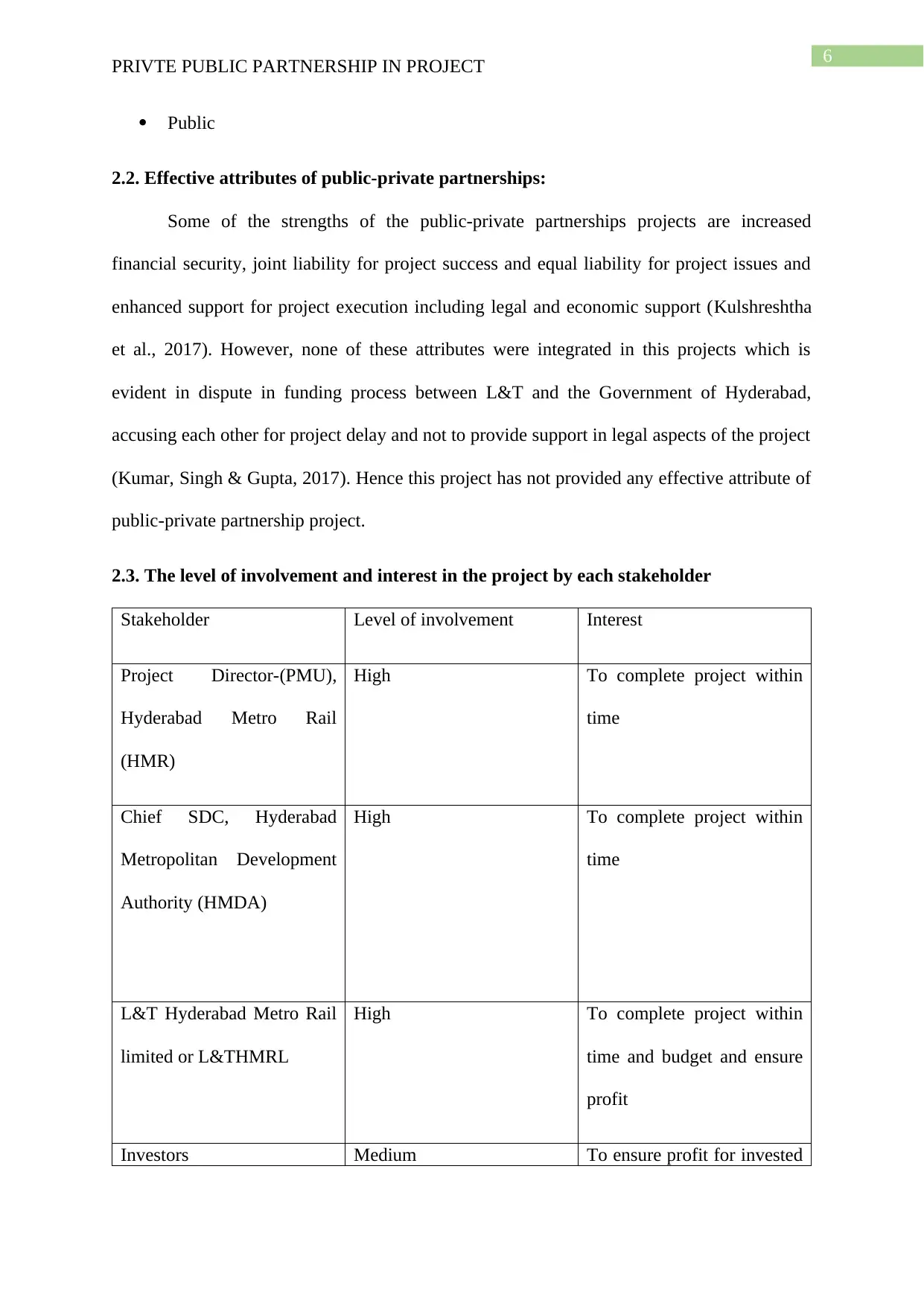
6
PRIVTE PUBLIC PARTNERSHIP IN PROJECT
Public
2.2. Effective attributes of public-private partnerships:
Some of the strengths of the public-private partnerships projects are increased
financial security, joint liability for project success and equal liability for project issues and
enhanced support for project execution including legal and economic support (Kulshreshtha
et al., 2017). However, none of these attributes were integrated in this projects which is
evident in dispute in funding process between L&T and the Government of Hyderabad,
accusing each other for project delay and not to provide support in legal aspects of the project
(Kumar, Singh & Gupta, 2017). Hence this project has not provided any effective attribute of
public-private partnership project.
2.3. The level of involvement and interest in the project by each stakeholder
Stakeholder Level of involvement Interest
Project Director-(PMU),
Hyderabad Metro Rail
(HMR)
High To complete project within
time
Chief SDC, Hyderabad
Metropolitan Development
Authority (HMDA)
High To complete project within
time
L&T Hyderabad Metro Rail
limited or L&THMRL
High To complete project within
time and budget and ensure
profit
Investors Medium To ensure profit for invested
PRIVTE PUBLIC PARTNERSHIP IN PROJECT
Public
2.2. Effective attributes of public-private partnerships:
Some of the strengths of the public-private partnerships projects are increased
financial security, joint liability for project success and equal liability for project issues and
enhanced support for project execution including legal and economic support (Kulshreshtha
et al., 2017). However, none of these attributes were integrated in this projects which is
evident in dispute in funding process between L&T and the Government of Hyderabad,
accusing each other for project delay and not to provide support in legal aspects of the project
(Kumar, Singh & Gupta, 2017). Hence this project has not provided any effective attribute of
public-private partnership project.
2.3. The level of involvement and interest in the project by each stakeholder
Stakeholder Level of involvement Interest
Project Director-(PMU),
Hyderabad Metro Rail
(HMR)
High To complete project within
time
Chief SDC, Hyderabad
Metropolitan Development
Authority (HMDA)
High To complete project within
time
L&T Hyderabad Metro Rail
limited or L&THMRL
High To complete project within
time and budget and ensure
profit
Investors Medium To ensure profit for invested
Paraphrase This Document
Need a fresh take? Get an instant paraphrase of this document with our AI Paraphraser
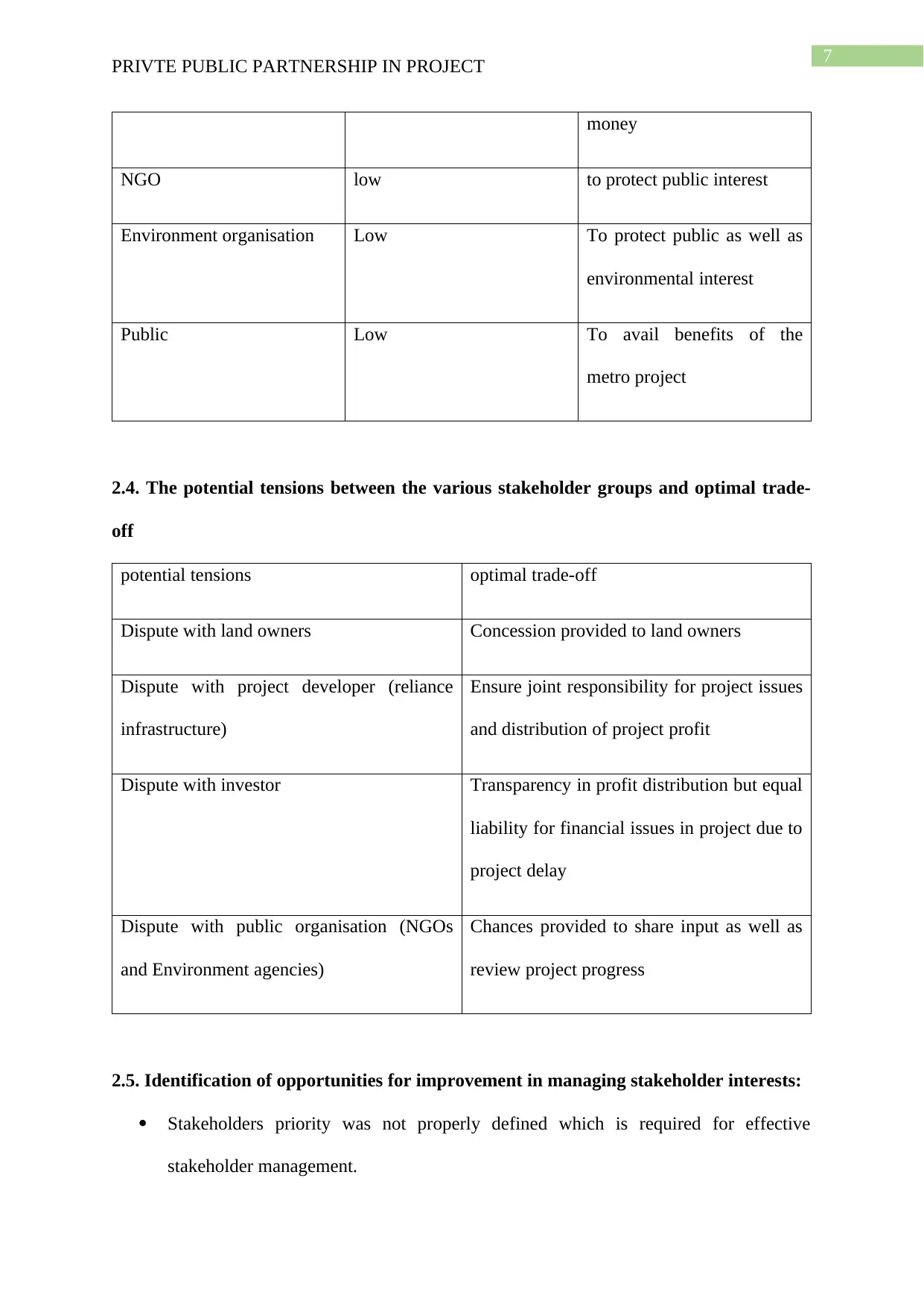
7
PRIVTE PUBLIC PARTNERSHIP IN PROJECT
money
NGO low to protect public interest
Environment organisation Low To protect public as well as
environmental interest
Public Low To avail benefits of the
metro project
2.4. The potential tensions between the various stakeholder groups and optimal trade-
off
potential tensions optimal trade-off
Dispute with land owners Concession provided to land owners
Dispute with project developer (reliance
infrastructure)
Ensure joint responsibility for project issues
and distribution of project profit
Dispute with investor Transparency in profit distribution but equal
liability for financial issues in project due to
project delay
Dispute with public organisation (NGOs
and Environment agencies)
Chances provided to share input as well as
review project progress
2.5. Identification of opportunities for improvement in managing stakeholder interests:
Stakeholders priority was not properly defined which is required for effective
stakeholder management.
PRIVTE PUBLIC PARTNERSHIP IN PROJECT
money
NGO low to protect public interest
Environment organisation Low To protect public as well as
environmental interest
Public Low To avail benefits of the
metro project
2.4. The potential tensions between the various stakeholder groups and optimal trade-
off
potential tensions optimal trade-off
Dispute with land owners Concession provided to land owners
Dispute with project developer (reliance
infrastructure)
Ensure joint responsibility for project issues
and distribution of project profit
Dispute with investor Transparency in profit distribution but equal
liability for financial issues in project due to
project delay
Dispute with public organisation (NGOs
and Environment agencies)
Chances provided to share input as well as
review project progress
2.5. Identification of opportunities for improvement in managing stakeholder interests:
Stakeholders priority was not properly defined which is required for effective
stakeholder management.
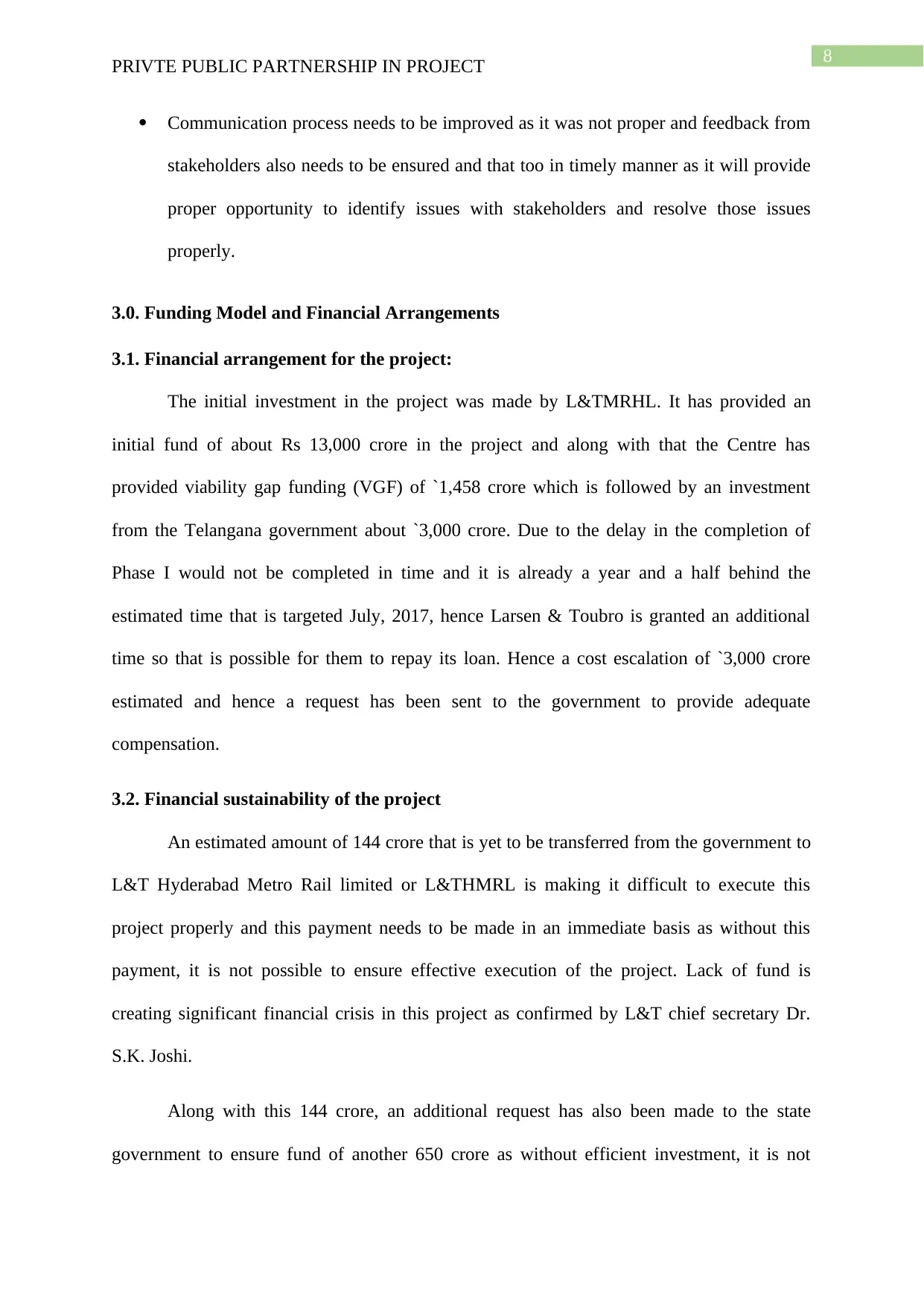
8
PRIVTE PUBLIC PARTNERSHIP IN PROJECT
Communication process needs to be improved as it was not proper and feedback from
stakeholders also needs to be ensured and that too in timely manner as it will provide
proper opportunity to identify issues with stakeholders and resolve those issues
properly.
3.0. Funding Model and Financial Arrangements
3.1. Financial arrangement for the project:
The initial investment in the project was made by L&TMRHL. It has provided an
initial fund of about Rs 13,000 crore in the project and along with that the Centre has
provided viability gap funding (VGF) of `1,458 crore which is followed by an investment
from the Telangana government about `3,000 crore. Due to the delay in the completion of
Phase I would not be completed in time and it is already a year and a half behind the
estimated time that is targeted July, 2017, hence Larsen & Toubro is granted an additional
time so that is possible for them to repay its loan. Hence a cost escalation of `3,000 crore
estimated and hence a request has been sent to the government to provide adequate
compensation.
3.2. Financial sustainability of the project
An estimated amount of 144 crore that is yet to be transferred from the government to
L&T Hyderabad Metro Rail limited or L&THMRL is making it difficult to execute this
project properly and this payment needs to be made in an immediate basis as without this
payment, it is not possible to ensure effective execution of the project. Lack of fund is
creating significant financial crisis in this project as confirmed by L&T chief secretary Dr.
S.K. Joshi.
Along with this 144 crore, an additional request has also been made to the state
government to ensure fund of another 650 crore as without efficient investment, it is not
PRIVTE PUBLIC PARTNERSHIP IN PROJECT
Communication process needs to be improved as it was not proper and feedback from
stakeholders also needs to be ensured and that too in timely manner as it will provide
proper opportunity to identify issues with stakeholders and resolve those issues
properly.
3.0. Funding Model and Financial Arrangements
3.1. Financial arrangement for the project:
The initial investment in the project was made by L&TMRHL. It has provided an
initial fund of about Rs 13,000 crore in the project and along with that the Centre has
provided viability gap funding (VGF) of `1,458 crore which is followed by an investment
from the Telangana government about `3,000 crore. Due to the delay in the completion of
Phase I would not be completed in time and it is already a year and a half behind the
estimated time that is targeted July, 2017, hence Larsen & Toubro is granted an additional
time so that is possible for them to repay its loan. Hence a cost escalation of `3,000 crore
estimated and hence a request has been sent to the government to provide adequate
compensation.
3.2. Financial sustainability of the project
An estimated amount of 144 crore that is yet to be transferred from the government to
L&T Hyderabad Metro Rail limited or L&THMRL is making it difficult to execute this
project properly and this payment needs to be made in an immediate basis as without this
payment, it is not possible to ensure effective execution of the project. Lack of fund is
creating significant financial crisis in this project as confirmed by L&T chief secretary Dr.
S.K. Joshi.
Along with this 144 crore, an additional request has also been made to the state
government to ensure fund of another 650 crore as without efficient investment, it is not
⊘ This is a preview!⊘
Do you want full access?
Subscribe today to unlock all pages.

Trusted by 1+ million students worldwide
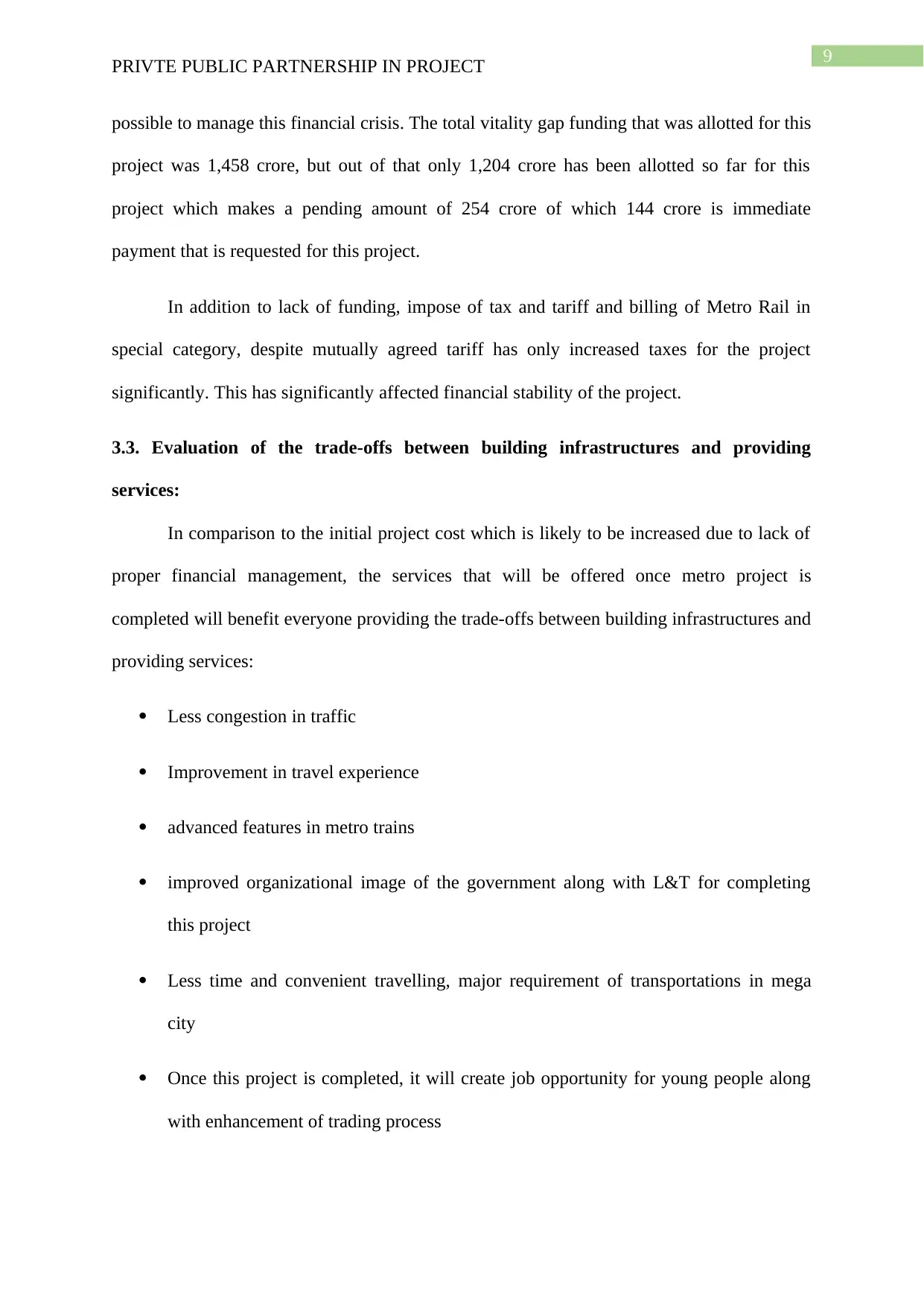
9
PRIVTE PUBLIC PARTNERSHIP IN PROJECT
possible to manage this financial crisis. The total vitality gap funding that was allotted for this
project was 1,458 crore, but out of that only 1,204 crore has been allotted so far for this
project which makes a pending amount of 254 crore of which 144 crore is immediate
payment that is requested for this project.
In addition to lack of funding, impose of tax and tariff and billing of Metro Rail in
special category, despite mutually agreed tariff has only increased taxes for the project
significantly. This has significantly affected financial stability of the project.
3.3. Evaluation of the trade-offs between building infrastructures and providing
services:
In comparison to the initial project cost which is likely to be increased due to lack of
proper financial management, the services that will be offered once metro project is
completed will benefit everyone providing the trade-offs between building infrastructures and
providing services:
Less congestion in traffic
Improvement in travel experience
advanced features in metro trains
improved organizational image of the government along with L&T for completing
this project
Less time and convenient travelling, major requirement of transportations in mega
city
Once this project is completed, it will create job opportunity for young people along
with enhancement of trading process
PRIVTE PUBLIC PARTNERSHIP IN PROJECT
possible to manage this financial crisis. The total vitality gap funding that was allotted for this
project was 1,458 crore, but out of that only 1,204 crore has been allotted so far for this
project which makes a pending amount of 254 crore of which 144 crore is immediate
payment that is requested for this project.
In addition to lack of funding, impose of tax and tariff and billing of Metro Rail in
special category, despite mutually agreed tariff has only increased taxes for the project
significantly. This has significantly affected financial stability of the project.
3.3. Evaluation of the trade-offs between building infrastructures and providing
services:
In comparison to the initial project cost which is likely to be increased due to lack of
proper financial management, the services that will be offered once metro project is
completed will benefit everyone providing the trade-offs between building infrastructures and
providing services:
Less congestion in traffic
Improvement in travel experience
advanced features in metro trains
improved organizational image of the government along with L&T for completing
this project
Less time and convenient travelling, major requirement of transportations in mega
city
Once this project is completed, it will create job opportunity for young people along
with enhancement of trading process
Paraphrase This Document
Need a fresh take? Get an instant paraphrase of this document with our AI Paraphraser
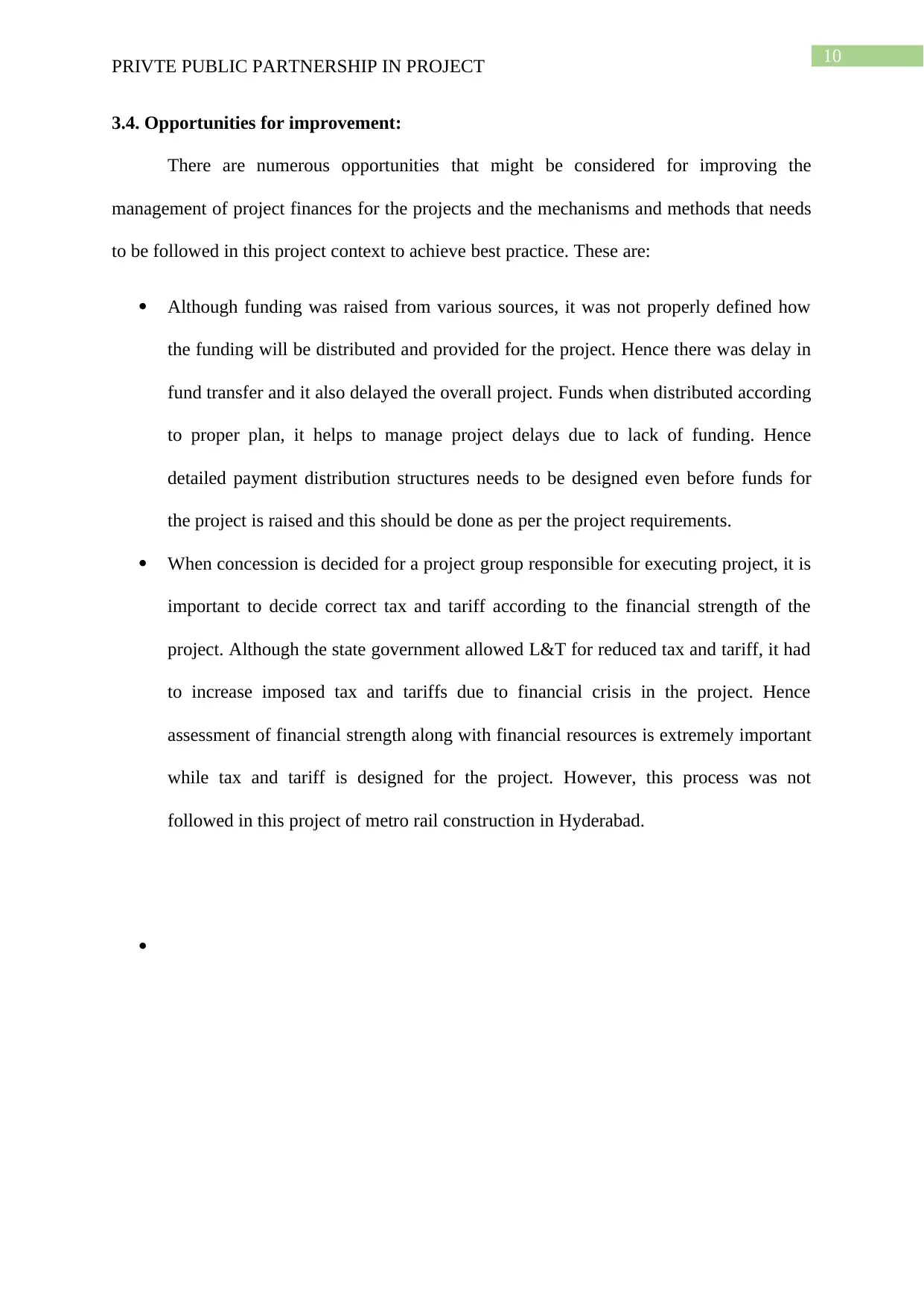
10
PRIVTE PUBLIC PARTNERSHIP IN PROJECT
3.4. Opportunities for improvement:
There are numerous opportunities that might be considered for improving the
management of project finances for the projects and the mechanisms and methods that needs
to be followed in this project context to achieve best practice. These are:
Although funding was raised from various sources, it was not properly defined how
the funding will be distributed and provided for the project. Hence there was delay in
fund transfer and it also delayed the overall project. Funds when distributed according
to proper plan, it helps to manage project delays due to lack of funding. Hence
detailed payment distribution structures needs to be designed even before funds for
the project is raised and this should be done as per the project requirements.
When concession is decided for a project group responsible for executing project, it is
important to decide correct tax and tariff according to the financial strength of the
project. Although the state government allowed L&T for reduced tax and tariff, it had
to increase imposed tax and tariffs due to financial crisis in the project. Hence
assessment of financial strength along with financial resources is extremely important
while tax and tariff is designed for the project. However, this process was not
followed in this project of metro rail construction in Hyderabad.
PRIVTE PUBLIC PARTNERSHIP IN PROJECT
3.4. Opportunities for improvement:
There are numerous opportunities that might be considered for improving the
management of project finances for the projects and the mechanisms and methods that needs
to be followed in this project context to achieve best practice. These are:
Although funding was raised from various sources, it was not properly defined how
the funding will be distributed and provided for the project. Hence there was delay in
fund transfer and it also delayed the overall project. Funds when distributed according
to proper plan, it helps to manage project delays due to lack of funding. Hence
detailed payment distribution structures needs to be designed even before funds for
the project is raised and this should be done as per the project requirements.
When concession is decided for a project group responsible for executing project, it is
important to decide correct tax and tariff according to the financial strength of the
project. Although the state government allowed L&T for reduced tax and tariff, it had
to increase imposed tax and tariffs due to financial crisis in the project. Hence
assessment of financial strength along with financial resources is extremely important
while tax and tariff is designed for the project. However, this process was not
followed in this project of metro rail construction in Hyderabad.
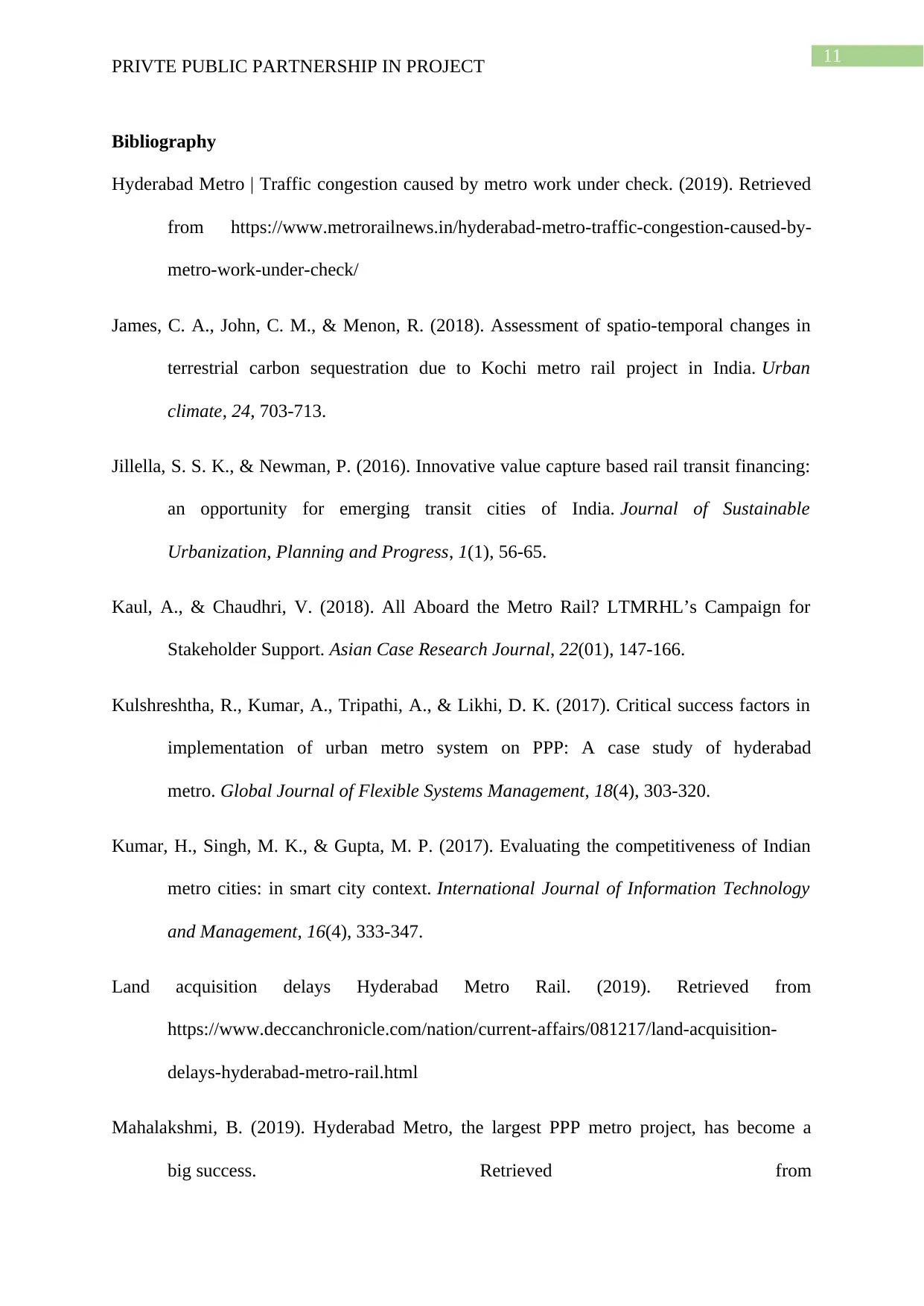
11
PRIVTE PUBLIC PARTNERSHIP IN PROJECT
Bibliography
Hyderabad Metro | Traffic congestion caused by metro work under check. (2019). Retrieved
from https://www.metrorailnews.in/hyderabad-metro-traffic-congestion-caused-by-
metro-work-under-check/
James, C. A., John, C. M., & Menon, R. (2018). Assessment of spatio-temporal changes in
terrestrial carbon sequestration due to Kochi metro rail project in India. Urban
climate, 24, 703-713.
Jillella, S. S. K., & Newman, P. (2016). Innovative value capture based rail transit financing:
an opportunity for emerging transit cities of India. Journal of Sustainable
Urbanization, Planning and Progress, 1(1), 56-65.
Kaul, A., & Chaudhri, V. (2018). All Aboard the Metro Rail? LTMRHL’s Campaign for
Stakeholder Support. Asian Case Research Journal, 22(01), 147-166.
Kulshreshtha, R., Kumar, A., Tripathi, A., & Likhi, D. K. (2017). Critical success factors in
implementation of urban metro system on PPP: A case study of hyderabad
metro. Global Journal of Flexible Systems Management, 18(4), 303-320.
Kumar, H., Singh, M. K., & Gupta, M. P. (2017). Evaluating the competitiveness of Indian
metro cities: in smart city context. International Journal of Information Technology
and Management, 16(4), 333-347.
Land acquisition delays Hyderabad Metro Rail. (2019). Retrieved from
https://www.deccanchronicle.com/nation/current-affairs/081217/land-acquisition-
delays-hyderabad-metro-rail.html
Mahalakshmi, B. (2019). Hyderabad Metro, the largest PPP metro project, has become a
big success. Retrieved from
PRIVTE PUBLIC PARTNERSHIP IN PROJECT
Bibliography
Hyderabad Metro | Traffic congestion caused by metro work under check. (2019). Retrieved
from https://www.metrorailnews.in/hyderabad-metro-traffic-congestion-caused-by-
metro-work-under-check/
James, C. A., John, C. M., & Menon, R. (2018). Assessment of spatio-temporal changes in
terrestrial carbon sequestration due to Kochi metro rail project in India. Urban
climate, 24, 703-713.
Jillella, S. S. K., & Newman, P. (2016). Innovative value capture based rail transit financing:
an opportunity for emerging transit cities of India. Journal of Sustainable
Urbanization, Planning and Progress, 1(1), 56-65.
Kaul, A., & Chaudhri, V. (2018). All Aboard the Metro Rail? LTMRHL’s Campaign for
Stakeholder Support. Asian Case Research Journal, 22(01), 147-166.
Kulshreshtha, R., Kumar, A., Tripathi, A., & Likhi, D. K. (2017). Critical success factors in
implementation of urban metro system on PPP: A case study of hyderabad
metro. Global Journal of Flexible Systems Management, 18(4), 303-320.
Kumar, H., Singh, M. K., & Gupta, M. P. (2017). Evaluating the competitiveness of Indian
metro cities: in smart city context. International Journal of Information Technology
and Management, 16(4), 333-347.
Land acquisition delays Hyderabad Metro Rail. (2019). Retrieved from
https://www.deccanchronicle.com/nation/current-affairs/081217/land-acquisition-
delays-hyderabad-metro-rail.html
Mahalakshmi, B. (2019). Hyderabad Metro, the largest PPP metro project, has become a
big success. Retrieved from
⊘ This is a preview!⊘
Do you want full access?
Subscribe today to unlock all pages.

Trusted by 1+ million students worldwide
1 out of 13
Your All-in-One AI-Powered Toolkit for Academic Success.
+13062052269
info@desklib.com
Available 24*7 on WhatsApp / Email
![[object Object]](/_next/static/media/star-bottom.7253800d.svg)
Unlock your academic potential
Copyright © 2020–2025 A2Z Services. All Rights Reserved. Developed and managed by ZUCOL.